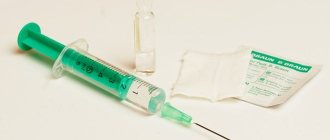Vegetative-vascular dystonia is a whole complex of symptoms that can cause great problems for a person. This diagnosis hides various pathologies - disruption of the endocrine system, mental disorders, headaches, heart damage, etc. Scientists and doctors continue to study the features of VSD and methods of its treatment, but the optimal way to get rid of the disease has not yet been found. At the same time, experts offer various treatment methods, one of which is the use of Mexidol for VSD. This is a new generation antioxidant, which has recently become increasingly popular, so it should definitely be discussed when it comes to the treatment of vegetative-vascular dystonia.
Since a person with VSD experiences symptoms of brain dysfunction, doctors decided to conduct experiments, as a result of which they came to the conclusion that the medicine has a positive effect on a person’s physical performance, eliminates the feeling of fatigue, and normalizes the functioning of the human nervous system.
What else can you say about this product? The main active ingredient is ethylmethylhydroxypyridine succinate, which copes well with various mental disorders, improves immunity and improves the absorption of oxygen by the body. The drug is available in several forms: capsules, tablets and solution for injection. Each of these types has its own characteristics of use, contraindications and other aspects that need to be known before use.
- normalizes brain function;
- strengthens the immune system;
- stops pain and inflammation;
- prevents the development of diseases associated with mental disorders;
- promotes the absorption of oxygen in brain tissue.
- Poor blood circulation in the brain.
- Exhaustion of the body and feeling tired.
- Age up to 18 years.
- Hypersensitivity.
Mexidol is prescribed for the following symptoms:
It should be noted that side effects of the drug include: feeling of drowsiness, nausea and possibly vomiting, allergies, dry mouth.
If, after using Mexidol, at least one of the above-mentioned side effects is observed, you should immediately stop treatment and seek professional help from a doctor who will tell you what to do next.
Features of VSD treatment
What is an antioxidant? This is a drug whose action is aimed at protecting cells from harmful reactions that occur in the body for various reasons. The antioxidant Mexidol is prescribed to people for various neurotic disorders, as well as for disorders of the circulatory process that occurs in the human brain.
It should be noted that all information provided below is for informational purposes only. Under no circumstances should you take Mexidol on your own; this must be authorized by your attending physician, who will initially make the correct diagnosis and then prescribe the appropriate medications.
We can talk about the functions of the product endlessly, because it has a wide spectrum of action:
There are several types of VSD, and Mexidol can be used for each of them. For example, the cardialgic type, in this case a person experiences pain in the heart, the pulse quickens, and the blood pressure rises. The drug allows you to get rid of such symptoms, reduces mental stress and normalizes blood pressure. The tachycardial type is accompanied by blood pounding in the temples, rapid pulse and increased blood pressure. The drug allows you to normalize the pulse, improve a person’s attention and memory.
“After using Mexidol, I really felt improvements. I encountered the symptoms of VSD several years ago, tried various drugs for treatment, some of them helped, others did not, but only after using this antioxidant the headaches decreased and the nervous system became more stable. Although I know for sure that the medicine is not suitable for every person, since it caused an allergic reaction in a friend of mine. In any case, ask your doctor."
Currently, the remedy is being vigorously discussed on various medical forums and websites, there are various rumors about it and there are absolutely opposite opinions. You will have to independently consider all the advantages and disadvantages of the drug, then consult with your doctor and make an informed decision - whether it is worth taking Mexidol for VSD or not.
psycholekar.ru
Differentiated interictal therapy of migraine
Migraine is a paroxysmal disease that manifests itself as attacks of predominantly unilateral throbbing headache, usually accompanied by nausea, vomiting, phono- and/or photophobia. In the general population, migraines affect 5-7% of men and 18-20% of women. Most often, migraine occurs at a young age - 17-25 years (about 70% of cases); the maximum number of clinically manifested cases occurs at the most working age of 25-35 years.
The pathogenesis of migraine is complex and not well understood. It is believed that in the first phase of a migraine attack, serotonin is released from platelets. Increased serotonin (5-HT) levels lead to vasoconstriction. In the headache phase, there is an increase in the excretion of serotonin and its metabolites in the urine, followed by a decrease in its content in the plasma and central nervous system (CNS).
As a result, hypotension of the cerebral vessels, their excessive stretching, perivascular edema, and irritation of pain receptors develop. A decrease in the level of 5-HT in the central nervous system leads to dysfunction of the endogenous serotonergic antinociceptive system and disruption of the central regulation of pain sensitivity.
Vasoconstriction helps reduce blood flow in certain areas of the brain. In this case, hypoxia occurs with a decrease in the energy balance of the brain, activation of anaerobic glycolysis, the formation of a significant amount of lactic acid, and the development of acidosis, which aggravates further metabolic disorders.
The next link in metabolic disorders during hypoxia is the activation of lipid peroxidation processes. During ischemia, lipid peroxidation has its own characteristics, which consist in the absence of the supply of antioxidants from the outside, which normally inhibit the process of peroxidation.
In connection with the above, we proposed Mexidol for interictal treatment of migraine. The drug has a wide range of pharmacological activity; increases the body's resistance to stress, oxygen-dependent pathological conditions, exhibits nootropic, antihypoxic and antioxidant properties.
The purpose of the work was a comparative study of the antimigraine activity of pizotifen, mexidol and their combination in the treatment of migraine in the interictal period.
Pizotifen (sandomigran) is considered the most effective antiserotonin antimigraine drug (5-HT2 receptor antagonist) and has mild side effects. It is prescribed orally at a dose of 3 mg per day; Duration of treatment is 6-12 months. The drug has a strong antiserotonin and antihistamine effect.
READ MORE: How to treat dizziness with migraines
In addition, it acts antagonistically towards tryptamine and acetylcholine, while at the same time it is an antiamine agent. Adverse reactions include increased appetite and weight gain. Less common is drowsiness, which disappears during treatment. Due to its similarity with tricyclic thymoleptic drugs, pizotifen has an antidepressant effect and stabilizes vasomotor reactions.
30 patients suffering from migraine without aura, aged from 15 to 33 years, were examined. Women predominated (68%). In most cases (24 people, 80%) there were weekly attacks, in the rest (6 people, 20%) - 2-3 severe paroxysms per month.
Migraine was diagnosed based on criteria proposed by the International Headache Society. In order to assess the effectiveness of migraine treatment, diaries filled out daily by patients were used to describe the type of headache, duration, degree of impairment of general well-being and performance, associated symptoms, autonomic dysfunctions, the number of analgesics taken, and drug tolerance. A positive result of therapy was considered to be a reduction in the frequency of migraine attacks by 50% or more from the initial level.
The patients were divided into three groups of 10 people, identical in gender, age, frequency, severity of migraine attacks and other parameters.
One group of patients received Mexidol, which was prescribed as monotherapy at a dose of 375 mg per day, divided into three doses of 125 mg (1 tablet), the second group received pizotifen (3 mg per day), the third - pizotifen (3 mg per day) in combination with Mexidol (375 mg per day). The duration of therapy was 3 months.
8 patients (80%) received the full course of treatment, taking pizotifen, 9 (90%) - Mexidol, 10 (100%) - both drugs. Three patients were excluded from the study: 1 due to a side effect, 2 for reasons unrelated to the medication. One patient taking pizotifen experienced an adverse reaction—drowsiness.
A decrease in headache intensity and attack duration was noted by patients in all three groups. A decrease in the frequency of attacks by 50% or more compared to the baseline was observed in 7 patients (87.5%) taking pizotifen, 8 (88.9%) taking Mexidol, and 10 (100%) taking combination therapy.
Therefore, these drugs are approximately the same in effectiveness. However, the inclusion of the universal antioxidant-antihypoxant Mexidol in the treatment complex promotes significant clinical improvement, which corresponds to the pathophysiological concept of the disease about the role of hypoxia and oxidative stress in its pathogenesis. Further research in this direction will contribute to the emergence of new effective anti-migraine drugs.
Sources used: www.plaintest.com
Mexidol for neuroses and VSD
Vegetative-vascular dystonia is a complex and rather controversial disease. This is due to the fact that VSD includes a large number of symptoms indicating pathologies of various systems of the human body. It is quite difficult to diagnose vegetative-vascular dystonia, as well as to cure it. A patient suffering from this disease needs consultations with several specialists:
A huge part of the population suffers from vegetative-vascular dystonia. This is due to the fact that people experience constant stress, psychological and physical stress, abuse bad habits, and so on.
Before prescribing treatment, it is necessary for the doctor to interview the patient in detail and find out the cause of the disease and the severe symptoms, since it is the cause that determines what future treatment will be. The main measures in the treatment of vegetative-vascular dystonia are:
Since vegetative-vascular dystonia is primarily a disease of a psychogenic and neuralgic nature, quite often the patient may be prescribed tranquilizers (antidepressants). Taking such medications is fraught with a large number of side effects from various body systems.
Side effects from antidepressants include effects on driving, insomnia, severe headaches, confusion, loss of coordination and even suicidal behavior and thoughts (often when the drug is first prescribed), addiction to the drug, the list of side effects from this type of medicine goes on endlessly. In addition, it is very difficult to choose a tranquilizer for a particular patient; it is usually necessary to try several before you can choose the most suitable one.
Recently, the antioxidant Mexidol has become very popular in the fight against dystonia.
This medicine is an antioxidant agent that has nothing in common with strong antidepressants. Mexidol is often prescribed for neurosis and depression.
What are the characteristics of migraine with aura?
About 20% of patients experience an aura. But only a few say that it occurs with every attack. The most common symptom of an aura is visual disturbances. Less commonly – sensory organ disorders (tingling, numbness, goosebumps). Aura symptoms are divided into positive and negative. In the first case, something is felt, and in the second, the fields of vision disappear or the hands go numb. Another property of the aura is dynamism. That is, a gradual increase in symptoms, and then their gradual decline. Usually the aura is replaced by a headache, but sometimes the aura appears on its own.
Migraine with aura is characterized by the following symptoms:
- Two episodes of migraine without aura.
- The presence of an aura for 1 hour or more before pain occurs. In this case, the following neurological symptoms appear - one or more: visual disturbances - photophobia, blinking, black spots in the field of vision, flickering arches, lines, zigzags, incorrect perception of objects in the field of vision;
- sound disorders, mainly intolerance to any sounds;
- speech problems;
- sensory disturbances – tingling, burning, numbness, etc.;
- impairment of motor abilities, such as sudden weakening of muscles on one side of the body.
Symptoms of the disease
The symptoms of vegetative-vascular dystonia are similar to the symptoms of neurosis:
Migraine treatment, prevention, diet
Treating migraines is not an easy task. It is very difficult to relieve attacks of migraine headaches, sometimes it comes to the development of migraine status - in this case, treatment is carried out in a hospital setting. Therefore, the prevention of migraine attacks is of great importance - a healthy lifestyle and avoidance of stress.
What is migraine and its main manifestations
Migraine is a pulsating headache that is constantly recurring, triggered by various factors. The headache usually hurts on one side; during the next attack, the side may change. But this is not necessary; sometimes a migraine attack is accompanied by a general headache.
A migraine attack is accompanied by a sharp, sudden dilation of the blood vessels in the brain. In this case, before a sharp expansion, a short-term spasm of blood vessels is observed, which the patient feels as a harbinger of a headache (aura). An aura most often manifests itself in the form of blurred vision and a grid before the eyes.
Migraine can be classic (ophthalmic, with an aura, which is followed by headache Headache in one half of the head, nausea and vomiting), simple (without aura, but longer lasting), associated (with transient neurological disorders), facial (pain in the lower half face), in the form of status migraine (a series of attacks accompanied by severe headache, vomiting and dehydration) and complicated (after an attack of such a migraine, neurological disorders remain that pass very slowly, and sometimes remain forever).
READ MORE: Arrhythmia, dizziness, weakness - Treatment of hypertension
The development of a migraine attack can be triggered by stress, strong odors, very bright light, strong sound, changes in weather, disruption of the usual rhythm of life, the rhythm of nutrition, eating spicy foods, smoked meats, and hard cheeses.
How can you relieve a migraine attack?
First of all, the patient should not panic - it can intensify the symptoms of migraine and make the attack longer. Anyone who suffers from migraine should know that the attack will pass, even if it is not treated at all.
Patients who have been suffering from migraine for a long time know that treatment should begin as early as possible, with the appearance of warning signs and the onset of headache. All medications for migraine relief are divided into three groups:
- the first group of drugs (more often called first-line drugs) are conventional painkillers, often combined (paracetamol, pentalgin and others),
- the second group - drugs that include non-steroidal anti-inflammatory drugs or their combination with other painkillers (diclofenac, Nise and others); the first and second groups of drugs are often used simultaneously to enhance the analgesic effect;
- the third group is drugs that cause spasm of the blood vessels of the brain - ergotamine, dihydroergotamine, sumatriptan and others.
The patient can take drugs of the first and second groups independently, but drugs of the third group should only be prescribed by a doctor. This is due to the fact that the patient may make a mistake and mistake for a migraine a headache that occurs due to spasm of blood vessels in the brain. Taking sumatriptan in this case can lead to the development of ischemic stroke.
Migraine status can only be relieved in a hospital setting. A complex treatment is carried out with parenteral (bypassing the gastrointestinal tract) administration of drugs that relieve headaches, vomiting, stop dehydration and the development of various neurological symptoms (impaired sensitivity, movements, and so on).
Preventing migraine attacks
Prevention of migraine attacks is a healthy lifestyle, a rational daily routine with a change of work and rest, regular (at the same time) meals, avoidance of emotional stress and especially stress, exclusion from the diet Diet: foods you can't live without You can’t do without food that can cause a migraine attack (hard cheese, smoked meats, chocolate).
Frequent migraine attacks can be provoked by smoking, drinking alcohol, any intoxication, strong odors, strong sounds, bright light, lack of sleep, overwork, taking nitroglycerin (it causes cerebral vasodilation and headaches), and so on - each patient usually has his own a set of provoking factors. All of them should also be eliminated if possible.
If the patient is afraid of attacks and is constantly in anxious anticipation of their development, this can also provoke an attack, so anxiety should be relieved. This is best done by a psychotherapist.
Drug prevention of migraine is selected for each patient individually. It is performed when a patient develops two or more migraine attacks per month. In order to obtain a lasting effect, drug treatment must be used for a long time, up to six months or more.
Sources used: www.womenclub.ru
Migraine is a periodic attack of headache that usually lasts for equal periods of time and significantly reduces the patient’s quality of life. This article will discuss methods of treating migraine, including medicinal, non-medicinal and general preventive methods.
First of all, the patient should not panic - it can intensify the symptoms of migraine and make the attack longer. Everyone who suffers from migraine Migraine should know that the attack will pass, even if it is not treated at all.
Indications for use and contraindications.
Available in the form of tablets and solution for intravenous and intramuscular administration.
Indications for the use of this antioxidant are:
The drug should not be taken if the patient has liver or kidney failure.
Contraindications for use are acute renal/liver failure, individual intolerance and sensitivity to the main components of the antioxidant, pregnancy, and breastfeeding. The antioxidant agent has not yet been well studied for use in children.
Side effects and warnings.
The antioxidant does not have high toxicity, and therefore no pronounced side effects are observed. Possible nausea, dry mouth, allergic reactions.
The antioxidant does not affect coordination of movements and reflexes, however, during therapy, you should be careful and attentive when driving a car and when engaging in potentially hazardous activities.
The product reduces the toxicity of ethyl alcohol. Can be combined with other psychotropic drugs. Enhances the effect of anticonvulsants, analgesics, antidepressants, benzodiazepines and carbamazepine.
Important! The antioxidant should not be used without a doctor's prescription. The specialist, if necessary, will prescribe the drug after diagnostic measures and making a diagnosis.
Causes of migraine with aura
The reasons have not yet been fully studied. It is believed that heredity and lifestyle matter. However, every person suffering from migraine can say exactly what causes an attack specifically for them.
Main triggering mechanisms:
- severe stress;
- hormonal imbalance, for example, women often experience migraines during menstruation;
- lack or excess of sleep;
- eating certain foods, such as tomatoes, cheese, chocolate, nuts, red wine, beer, citrus fruits;
- inhalation of tobacco smoke and/or exhaust fumes;
- long breaks between meals, which causes a drop in blood glucose levels;
- sitting for a long time in an uncomfortable position;
- other irritants - a pungent odor, a repulsive sound, very bright light.
Use of Mexidol for panic.
Panic attack, or episodic paroxysmal anxiety, is one of the types of neuralgic disorders. Panic in a person can manifest itself either independently or as a symptom of a disorder.
Panic is a sudden attack of intense fear that can last up to two hours. Panic attacks can occur even at night and gain intensity in just a few minutes. As a rule, such cases are accompanied by increased heart rate, attacks of nausea, chest pain, the patient lacks air or has difficulty breathing, as well as a feeling of a “lump” in the throat; everything that happens around seems unreal to the patient. The panic attack goes away on its own, leaving a feeling of anxiety for about an hour. The patient is always afraid of repetition.
A person may experience the attack just once, or may have repeated panic attacks over the course of one month, in which case it will not be considered a disorder. But if the patient experiences attack after attack for a year or more, then we can conclude that he suffers from panic attack syndrome, which will serve to change his personality.
For panic attacks, Mexidol is usually used for injection and is used as part of complex treatment. The drug is administered intravenously by jet method (200 mg of the drug 5%), diluted in a solution of sodium chloride (0.9%). If the attack of a sudden panic attack drags on, then the patient should be given up to 300 mg of solution by drip.
To prevent recurrence of attacks, the medicine can be administered either intravenously (100-200 mg mixed with saline solution 0.9%), or intramuscularly 100-200 mg twice a day. Therapy lasts up to fifteen days, at least ten.
It is also possible to use tablets instead of injections, however, the tablet form of release is less effective than injections. One tablet three times a day for one to one and a half months.
Customer reviews.
Elizaveta, 27 years old.
This drug helped me, but was initially prescribed as an injection, administered intramuscularly, into the buttock. The injection is quite painful. It turned out that before administering the medicine it is better to eat well, which I did not know, as a result, after the second time I fainted. After intravenous administration, I also experienced discomfort. Firstly, there is a sore throat and cough, and secondly, the taste of the medicine lingers in the throat. Perhaps an allergic reaction, which is mentioned in the instructions for Mexidol. Despite all the not so pleasant aspects of the use, there were still improvements, the dizziness disappeared, and clarity of thoughts appeared. However, the effect was a little more. Than for a month. I tried switching to pills. Saw according to instructions. I liked it more, since my general condition has stabilized, depression no longer comes, and a taste for life has appeared.
Alexander, 34 years old.
Initially, I was very skeptical about this drug, since it is not an antidepressant, but an antioxidant agent. But it helped me a lot!
I began to suffer from neurosis about a year and a half ago, the cause was problems in business and family life. Mexidol was prescribed to me by a doctor at a city clinic. And it turned out that it is very good that this medicine is not an antidepressant. It works differently, it just improves the overall condition, and there is no feeling that emotions are dulled, as after tranquilizers. I was also pleased with the average price. I felt the effect almost immediately, the feeling of anxiety and obsessive state went away. There were no side effects. He did not give up driving a car.
Svetlana, 45 years old.
Mexidol injections helped a lot with VSD. This is my salvation. The drug was recommended to me by a doctor, I use it as an addition to other medications. Ten days of the course are enough for stable remission to occur. I was simply exhausted by headaches and frequent dizziness, all of which went away with the help of this medicine. I also said goodbye to the feeling of anxiety. For at least six consecutive months, there was no need for any maintenance therapy.
A diagnosis of vegetative-vascular dystonia was made. I was most worried that they would again prescribe strong antidepressants or tranquilizers; after taking them I felt uncomfortable. But my doctor prescribed me the antioxidant drug Mexidol. To my surprise, the instructions contained almost no side effects, which was confirmed in practice. The price category suits me completely. I feel some kind of surge of strength after taking the antioxidant.
Click “Like” and receive only the best posts on Facebook ↓
1neurologia.ru
As is known, symptoms of dystonia can manifest themselves in both stressful and ordinary situations. These include constant headaches, asthenia, neurotic disorders, general weakness, the appearance of edema, breathing problems, etc. Often the disease is associated with mental disorders, which is why scientists have focused on treating the disease with the help of an antioxidant agent, which is Mexidol.
What does migraine with aura mean?
“Aura” is a term by which doctors mean the following:
- Visual impairment
. These can be lines, lights, spots, flickering. In severe cases, loss of vision. All manifestations are reversible. - Sensory perception disorders
. It seems that goosebumps are crawling all over the body, the person feels tingling, and there may be areas of numbness. All this is also reversible. - Speech disorders
, which also go away along with the attack.
Symptoms usually worsen within 5 minutes and can last up to 1 hour. The headache may occur simultaneously with the aura or no later than an hour after its onset. The types of aura are individual. Some suffer from visual impairments, others from speech impairments. It happens that a panic migraine develops. Its complications are fear, anxiety, etc.
Migraines with and without aura are the same. A person usually feels a throbbing pain in one side of the head. Often it is concentrated in the eyeball. The pain intensifies with movement, sound and light stimuli. It can last from 4 hours to 3 days. At this time, it is impossible to lead a normal lifestyle. A person wants to be left alone in a dark and cool room, freeze, hide under the blanket. Typically, patients describe the pain as “bursting,” “splitting,” “about to burst,” “every sound like a hammer on the head.” And even after an attack, the consequences persist. The person is apathetic, tired and overwhelmed. It takes more than one day to recover.
Mexidol: general information
Today Mexidol is a true leader in the pharmacological market. It is prescribed for problems with blood circulation in the brain, for mental disorders, as well as for activating a person’s mental activity. Recently, the drug has also been used for vegetative-vascular dystonia, and based on reviews of Mexidol for VSD, one can conclude that the medicine really helps.
Do not forget that self-medication with this drug is strictly contraindicated. Be sure to consult your doctor before taking an antioxidant for any medical condition.
Diagnosis of migraine with aura
The diagnosis is made by a neurologist, and it is he who should be contacted with such a problem as soon as possible. The doctor must rule out cysts, tumors, encephalitis and vascular pathologies that cause similar symptoms. Therefore, a neurological examination, CT or MRI of the brain is performed, and the patient is sent for a consultation with an ophthalmologist for examination and determination of visual fields.
An EEG (electroencephalography) is required, which provides information about the functional activity and characteristics of the brain biorhythm of a particular patient. Based on the EEG results, the doctor then selects medications for therapy.
Indications for use and contraindications
- Organic psychosyndrome.
- Period of pregnancy or lactation.
As you can see, all these symptoms can accompany a person with vegetative-vascular dystonia, and therefore the use of the drug is absolutely justified.
Contraindications include:
You should also refrain from using the product if you have allergic reactions to the main active ingredient Mexidol.
Here, first of all, you need to pay attention to how you use the drug: in the form of injections, in the form of capsules or tablets. If these are injections, then about 0.1 g of the product is taken for one injection; in total, 2-3 such injections are given per day.
Reviews of Mexidol tablets for VSD indicate that the maximum daily dose is 6 tablets, which is 800 mg. It is advisable to take the medicine 3 times a day, 250 mg. The course of treatment continues for the time prescribed by the doctor, as a rule, it does not exceed 5-6 weeks.
Types and symptoms of migraine auras
Let's look at the main types of auras and how they manifest themselves.
Visual or ophthalmological
This aura is called “classical”. With it, visual images appear - flashes of light, curved or straight lines, flickering objects, white or golden figures, spherical images, etc.
Symptoms develop over 5-30 minutes. Positive ones can be replaced by negative ones. The duration of the aura can reach 1 hour. The image usually appears in the center of the visual field. It gradually increases and moves to the periphery. A scotoma remains behind him
– dark, “blind” area. During the aura or within an hour after its appearance, pain occurs. When the attack ends, any disturbances go away without consequences.
Retinal
With such an aura, scotomas or blindness in one eye occur. Symptoms persist for up to 1 hour. The headache comes after scotomas in about an hour, but can also occur before them. This is a rare type of aura. There is an assumption that the symptoms appear due to spasm of the central retinal artery. In most patients, retinal migraine attacks alternate with migraine attacks with or without classic aura.
Auditory
Auditory auras are hallucinations with sound. Ringing in the ears may occur, and patients sometimes hear music or voices. Doctors associate this aura with epileptic activity in the cerebral cortex, in its temporal region.
Speech
It manifests itself as a speech disorder because it affects the speech centers of the brain. Before an attack of pain, for a few minutes, no more, it is difficult or impossible for a person to speak. He can rearrange syllables in words, letters, repeat the same thing. At the same time, the consciousness is absolutely pure.
Vestibular
This is an aura in the form of movement disorders - dizziness. A fairly common phenomenon that can be hidden or obvious. In the second case, a person “sicks” even with small loads. In the first, violations can only be detected within the framework of an examination. According to the ICD, 2 forms of vestibular migraine are distinguished:
- Basilar
- occurs rarely, mainly in teenage girls. The attack begins with visual disturbances, followed by dizziness, tinnitus, sensory disturbances, etc. Then, in 25% of cases, confusion occurs. Neurological symptoms persist for 20-30 minutes, then pain in the back of the head occurs. Without treatment, throbbing pain may persist for 2-3 days. - Paroxysmal dizziness of younger children
(benign). Occurs in children 1-4 years old. It manifests itself as short – from a few seconds to a few minutes – attacks of dizziness. The child loses stability, becomes anxious, and vomits. He may turn pale and sweat profusely. No headache. Attacks may recur over several months or years.
Vegetative
Often such auras are manifested by a feeling of heat, chills, cold, trembling; the face and neck may turn red or pale. Goosebumps may appear, and hairs may even rise on the skin. During an attack, the size of the pupil may change, and asymmetrically. Usually such an attack is part of a complex attack, and not an independent phenomenon.
Reviews about the drug
Before using any drug, people try to find out real reviews about it from other consumers. Here are some reviews about Mexidol:
“I found reviews somewhere about Mexidol for neuroses, and decided to try this remedy for the treatment of vegetative-vascular dystonia. Our doctors were somehow skeptical about my problem, and some of them even said that VSD does not exist at all, but they recommended taking this particular antioxidant drug. I won’t say that I was immediately cured of the disease or that all the symptoms disappeared, but there are definitely some changes for the better. Attacks of tachycardia began to bother me less, insomnia disappeared, and I gained more strength and energy.”
You can also find some negative reviews on the Internet, but there is no reason to consider such reviews to be true, since there is no evidence.
How to treat migraine with aura and how to relieve pain effectively and quickly
Since it is almost impossible to avoid an attack if there is a trigger, you need to know ways to improve the condition, because migraine is not a death sentence.
The final diagnosis is made by a neurologist. He will tell you what to do, how to treat the disease, how to increase the intervals between attacks.
Treatment for migraines is based on eliminating the pain and making it happen as little as possible or go away altogether. NSAIDs or specific medications, most often triptans, may be used. Intravenous infusion therapy is also used to treat migraines. The effectiveness of pain relief is directly proportional to the time of taking the drugs. You can stop an attack when it has just begun. Unfortunately, many people miss this moment with the thought “what if it doesn’t hurt.” However, at the peak of an attack, the tablets have almost no effect, because with migraine gastrostasis in the intestines, the absorption of any substances is very difficult.
Alternative ways to alleviate the condition are physical activity, exercise therapy, physiotherapy, and psychotherapy. Massage of the collar area is especially useful, because muscle spasm in this area can provoke an attack. Recently, migraines have been successfully treated with injections of botulinum toxin type A. The injections make remission last longer, and in some cases relieve pain for a very long time.
Treatment of migraines using traditional medicine
Many traditional medicine methods can provide relief from pain.
Ginger root
Ginger has the ability to block prostaglandins, thereby reducing the severity of pain. The same principle applies to most NSPVs. Ginger tea is prepared at home. Ginger root is crushed, then added to boiling water and simmered for 10 minutes over low heat. Next, the tea is filtered and drunk plain or with lemon and honey.
Chamomile
Has an anti-inflammatory and calming effect. You need to take two tablespoons of chamomile in a glass of water and cook the mixture for 5 minutes over low heat. Next, you need to strain the broth and drink it plain or with lemon and honey.
Lavender
Lavender oil is used for inhalation. The solution is prepared as follows: a teaspoon of oil is diluted in three glasses of boiling water. Breathe over the resulting solution for 15 minutes. Lavender oil can be mixed with peppermint oil and apply the mixture to the temples, gently massaging it a little. It is best to combine massage and inhalation.











